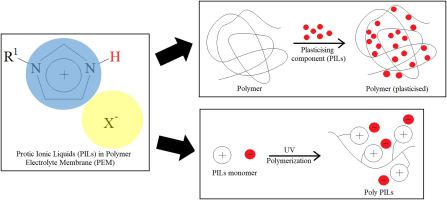Reactive & Functional Polymers ( IF 4.5 ) Pub Date : 2022-01-10 , DOI: 10.1016/j.reactfunctpolym.2022.105160 Chun Yik Wong 1 , Wai Yin Wong 1 , Kee Shyuan Loh 1 , Kean Long Lim 1

|
The development of protic ionic liquids (PILs) in proton exchange membrane has drawn significant interest. The intrinsic properties of high thermal stability and proton conductivity of PILs at high temperature (> 100 °C) enables fuel cell operation at anhydrous condition. This review discusses the roles of PILs in different types of polymeric membranes, including Nafion®, sulfonated poly(ether ether ketone) (SPEEK), poly(vinyl alcohol) (PVA), polybenzimidazole (PBI) and sulfonated polyimide (SPI). The plasticisation effect attributed to the presence of PILs increases the segmental mobility of the polymer chains and hence enable fast protons transport. The selection of anions and cations of PILs towards the improved proton conductivity of membrane was discussed. Novel synthesis strategies of next generation PILs-based solid polymer membrane such as polymerisation and chemical modification are highlighted to overcome the existing PIL leaching issue from the membrane. This PILs-based PEM mimics the structural of Nafion® by having ions attached to the polymeric chains in serving as the backbone of PEM and maintaining the mechanical integrity. Finally, the challenges beneath the development of PEM using PILs also been addressed along with future perspective to take the research into next phase.
中文翻译:

质子离子液体作为下一代质子交换膜材料:现状和未来展望
质子交换膜中质子离子液体 (PIL) 的开发引起了人们的极大兴趣。PIL在高温(> 100°C)下具有高热稳定性和质子传导性的固有特性使燃料电池能够在无水条件下运行。本综述讨论了 PIL 在不同类型聚合物膜中的作用,包括 Nafion®、磺化聚醚醚酮 (SPEEK)、聚乙烯醇 (PVA)、聚苯并咪唑 (PBI) 和磺化聚酰亚胺 (SPI)。归因于 PIL 的存在的增塑效应增加了聚合物链的分段流动性,从而使质子能够快速传输。讨论了选择PILs的阴离子和阳离子以提高膜的质子电导率。强调了下一代基于 PIL 的固体聚合物膜的新合成策略,例如聚合和化学改性,以克服现有的 PIL 从膜中浸出的问题。这种基于 PIL 的 PEM 模仿 Nafion® 的结构,将离子连接到聚合物链上,充当 PEM 的骨架并保持机械完整性。最后,还解决了使用 PIL 开发 PEM 所面临的挑战以及将研究带入下一阶段的未来前景。





















































 京公网安备 11010802027423号
京公网安备 11010802027423号